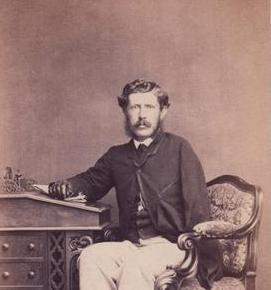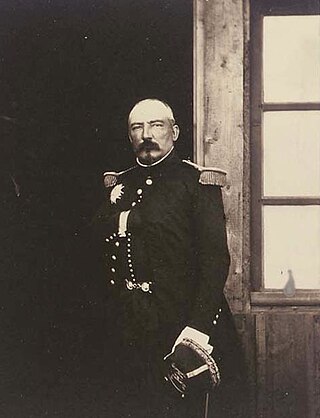
The Battle of the Alma took place during the Crimean War between an allied expeditionary force and Russian forces defending the Crimean Peninsula on 20 September 1854. The allies had made a surprise landing in Crimea on 14 September. The allied commanders, Maréchal Jacques Leroy de Saint-Arnaud and Lord Raglan, then marched toward the strategically important port city of Sevastopol, 45 km (28 mi) away. Russian commander Prince Alexander Sergeyevich Menshikov rushed his available forces to the last natural defensive position before the city, the Alma Heights, south of the Alma River.

The Battle of Inkerman was fought during the Crimean War on 5 November 1854 between the allied armies of Britain and France against the Imperial Russian Army. The battle broke the will of the Russian Army to defeat the allies in the field, and was followed by the Siege of Sevastopol. The role of troops fighting mostly on their own initiative due to the foggy conditions during the battle has earned the engagement the name "The Soldier's Battle."

The Battle of Balaclava, fought on 25 October 1854 during the Crimean War, was part of the Siege of Sevastopol (1854–55), an Allied attempt to capture the port and fortress of Sevastopol, Russia's principal naval base on the Black Sea. The engagement followed the earlier Allied victory in September at the Battle of the Alma, where the Russian General Menshikov had positioned his army in an attempt to stop the Allies progressing south towards their strategic goal. Alma was the first major encounter fought in the Crimean Peninsula since the Allied landings at Kalamita Bay on 14 September, and was a clear battlefield success; but a tardy pursuit by the Allies failed to gain a decisive victory, allowing the Russians to regroup, recover and prepare their defence.

General Lord Henry Hugh Manvers Percy, was a British Army officer and a recipient of the Victoria Cross, the highest award for gallantry in the face of the enemy that can be awarded to British and Commonwealth forces. Outside his military career he was briefly a Conservative Member of Parliament.

Lieutenant General Gerald Littlehales Goodlake VC was an English recipient of the Victoria Cross, the highest and most prestigious award for gallantry in the face of the enemy that can be awarded to British and Commonwealth forces.

Thomas Beach VC was a British Army soldier and a Scottish recipient of the Victoria Cross, the highest award for gallantry in the face of the enemy that can be awarded to British and Commonwealth forces. Beach suffered from severe alcoholism later in life. He died due to his alcoholism at the age of 40.

Major John Simpson VC was a Scottish recipient of the Victoria Cross, the highest and most prestigious award for gallantry in the face of the enemy that can be awarded to British and Commonwealth forces.

Daniel Cambridge VC born in Carrickfergus, County Antrim, Ireland, was an Irish recipient of the Victoria Cross, the highest and most prestigious award for gallantry in the face of the enemy that can be awarded to British and Commonwealth forces.

Brevet Major John Simpson Knox was a Scottish recipient of the Victoria Cross, the highest and most prestigious award for gallantry in the face of the enemy that can be awarded to British and Commonwealth forces.

General Sir Hugh Rowlands was a Welsh recipient of the Victoria Cross for courageous action that led to the rescue of Colonel William O'Grady Haly during the Crimean War.

Pierre François Joseph Bosquet was a French Army general. He served during the French conquest of Algeria and in the Crimean War of 1853-1856; returning from Crimea he was made a Marshal of France and a Senator.

The Siege of Sevastopol lasted from October 1854 until September 1855, during the Crimean War. The allies landed at Eupatoria on 14 September 1854, intending to make a triumphal march to Sevastopol, the capital of the Crimea, with 50,000 men. Major battles along the way were Alma, Balaklava, Inkerman, Tchernaya, Redan, and, finally, Malakoff. During the siege, the allied navy undertook six bombardments of the capital, on 17 October 1854; and on 9 April, 6 June, 17 June, 17 August, and 5 September 1855.

Inkerman is a city in the Crimean peninsula. It is de facto within the federal city of Sevastopol within the Russian Federation, but de jure within the Autonomous Republic of Crimea within Ukraine. It lies 5 kilometres east of Sevastopol, at the mouth of the Chernaya River which flows into Sevastopol Inlet. Administratively, Inkerman was subordinate to the municipality of Sevastopol, but since September 2023 it de jure became a part of Bakhchysarai Raion of AR Crimea. Population: 10,348 .

The Crimea Medal was a campaign medal approved on 15 December 1854, for issue to officers and men of British units which fought in the Crimean War of 1854–56 against Russia. The medal was awarded with the British version of the Turkish Crimea Medal, but when a consignment of these was lost at sea, some troops received the Sardinian version.

Edwin Hughes, nicknamed "Balaclava Ned", was a British Army soldier and the last survivor of the famous Charge of the Light Brigade during the Crimean War of 1854–56.

Lieutenant-Colonel Sir Thomas St Vincent Hope Cochrane Troubridge, 3rd Baronet CB was an officer of the British Army who served with distinction during the Crimean War.

The 49th (Hertfordshire) Regiment of Foot was a line infantry regiment of the British Army, raised in 1743. Under the Childers Reforms it amalgamated with the 66th (Berkshire) Regiment of Foot to form the Princess Charlotte of Wales's in 1881.
Sir George Bell KCB was an officer in the British Army. He served during the Peninsular War in the Napoleonic Wars, the First Anglo-Burmese War, the Rebellions of 1837 in Canada, and the Crimean War. During the Crimean War he saw action at the battles of Alma and Inkerman, and at the Siege of Sevastopol.

The Sebastopol Monument is a triumphal arch that is located in the Old Burial Ground, Halifax, Nova Scotia, Canada. The arch commemorates the Siege of Sevastopol (1854–1855), which is one of the last classic sieges of all time. This arch is the 4th oldest war monument in Canada (1860). It is the only monument to the Crimean War in North America. The arch and lion were built in 1860 by stone sculptor George Lang to commemorate British victory in the Crimean war and the Nova Scotians who had fought in the war.

The Sardinian Crimean War Medal or, more formally, the silver medal for Military Valour for the Eastern Expedition 1855–1856 was a gallantry medal awarded by King Victor Emmanuel II of Sardinia for bravery during the Crimean War (1855–1856) against the Russian Empire. It is a variant of the Sardinian Medal of Military Valor.




















